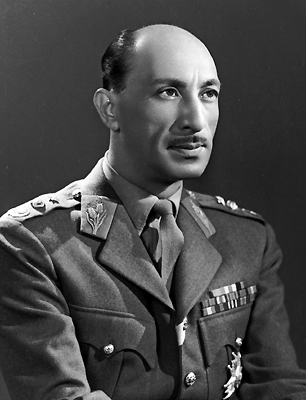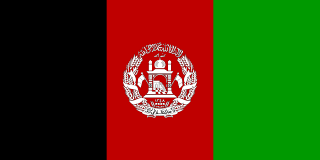
Mohammad Zahir Shah was the last King of Afghanistan, reigning from 8 November 1933 until he was deposed on 17 July 1973. Ruling for 40 years, Zahir Shah was the longest-serving ruler of Afghanistan since the foundation of the Durrani Empire in the 18th century.

The government of Afghanistan is currently disputed following the effective collapse of the Islamic Republic of Afghanistan during the fall of Kabul to Taliban forces on 15 August 2021 and the subsequent re-establishment of the Islamic Emirate of Afghanistan which now exercises de facto control over most of the country. On 7 September 2021 the Taliban officials in de facto control of most of Afghanistan announced a new interim government headed by Mullah Mohammad Hassan Akhund as Prime Minister. The government is subject to the oversight of the Taliban's Supreme Leader, Haibatullah Akhundzada. As of 8 September 2021, the Islamic Emirate of Afghanistan has not yet been formally recognized as the de jure government of Afghanistan by any other country. The representatives appointed by the Islamic Republic of Afghanistan continue to represent the country at the United Nations. These representatives have refused to recognize the Taliban appointed government and have urged other countries to not recognize this government either.

Hamid Karzai is an Afghan politician who served as the fourth president of Afghanistan from July 2002 to September 2014, including as the first elected president of the Islamic Republic of Afghanistan from December 2004 to September 2014. He previously served as Chairman of the Afghan Interim Administration from December 2001 to July 2002. He is the chief (khān) of the Popalzai Durrani tribe of Pashtuns in Kandahar Province.

This article on the history of Afghanistan covers the period from the fall of the Najibullah government in 1992 to the end of the international military presence in Afghanistan.

Hedayat Amin Arsala is an economist and a prominent politician in Afghanistan. Mr. Arsala is a former Vice President of Afghanistan, Finance Minister and Foreign Minister and until October 2013 was the Senior Minister of the Republic of Afghanistan, appointed by the President Hamid Karzai.
The Afghan Constitution Commission was established October 5, 2002 as required by the Bonn Agreement, which stipulated that a new Afghan constitution be adopted by a loya jirga. The loya jirga was required to convene within eighteen months of the establishment of Afghan Transitional Administration, which was established by the Emergency Loya Jirga in June 2002. After some delay, the proposed Afghan Constitution was presented to President Hamid Karzai on November 3, 2003. A loya jirga began December 14, 2003 in Kabul and was endorsed January 4, 2004.

Mohammad Qasim Fahim was an Afghan military commander and politician who served as Vice President of Afghanistan from June 2002 until December 2004 and from November 2009 until his death. He was considered a powerful and influential figure during the Karzai Administration.
A 502-delegate loya jirga convened in Kabul, Afghanistan, on December 14, 2003, to consider the proposed Afghan Constitution. Originally planned to last ten days, the assembly did not endorse the charter until January 4, 2004. As has been generally the case with these assemblies, the endorsement came by way of consensus rather than a vote. Afghanistan's last constitution was drafted for the Democratic Republic of Afghanistan in November 1987.

Abdul Rasul Sayyaf is an exiled Afghan politician and former mujahideen commander. He took part in the war against the Marxist–Leninist People's Democratic Party of Afghanistan (PDPA) government in the 1980s, leading the Afghan mujahideen faction Ittehad-al-Islami.

Younus Qanooni is an Afghan politician who was Vice President of Afghanistan. An ethnic Tajik, Qanooni is the leader of the Afghanistan e Naween political party and former Speaker of the House of the People.
A jirga is an assembly of leaders that makes decisions by consensus according to Pashtunwali, the Pashtun social code. It is conducted in order to settle disputes among the Pashtuns, but also by members of other ethnic groups who are influenced by them in present-day Afghanistan and Pakistan.

The Transitional Islamic State of Afghanistan (TISA), also known as the Afghan Transitional Authority, was the name of the temporary transitional government in Afghanistan put in place by the June 2002 loya jirga. The Transitional Authority succeeded the original Islamic State of Afghanistan, and preceded the Islamic Republic of Afghanistan (2004–2021).

The Council of Ministers of the Islamic Emirate of Afghanistan is the executive body of the government of Afghanistan, responsible for day-to-day governance and the implementation of policy set by the Leadership. It is headed by the prime minister—who serves as the nation's head of government—and his deputies, and consists of the heads and deputy heads of the government ministries.

Abdullah Abdullah is a Pashtun Afghan politician who led the High Council for National Reconciliation (HCNR) from May 2020 until August 2021, when the Afghan government was overthrown by the Taliban. The council had been established to facilitate peace talks between the Islamic Republic of Afghanistan and the Taliban insurgents. Abdullah served as the Chief Executive of Afghanistan from September 2014 to March 2020, and as Minister of Foreign Affairs from December 2001 to April 2005. Prior to that, he was a senior member of the Northern Alliance, working as an adviser to Ahmad Shah Massoud. He worked as an ophthalmologist and medical doctor in the 1980s.

After Operation Enduring Freedom in which the Taliban government was toppled in Afghanistan, in December 2001, the German city of Bonn hosted a conference – widely known as the Bonn Conference – of Afghan leaders at Hotel Petersberg, to choose the leader of an Afghan Interim Authority and establish an initial political agreement for reorganising the governmental institutions of Afghanistan. The Conference chose Hamid Karzai, who was subsequently elected President in 2004. Karzai subsequently appointed many anti-Taliban allies and regional leaders to senior posts within the interim government and to senior posts in the Provincial governments. The Conference set up the Bonn Agreement for institutional reorganisation.

The Karzai administration was the government of Afghanistan under President Hamid Karzai, who became the head of state of Afghanistan in December 2001 after the Taliban government was overthrown. Karzai was appointed at the 2002 Loya Jirga as the Interim President of the Afghan Transitional Administration. After the 2004 Afghan presidential election, he became the President of Afghanistan.
Afghan President Hamid Karzai announced the holding of a consultative grand council called the Afghanistan's National Consultative Peace Jirga (NCPJ) or Peace Jirga in his inauguration speech on 19 November 2009, after winning elections for a second term, to end the ongoing Taliban insurgency. At the International Afghanistan Conference in London on 28 January 2010, he announced that the government would hold the event in April or May 2010, intended to bring together tribal elders, officials and local power brokers from around the country, to discuss peace and the end of the insurgency. "Jirga" is a word in the Pashto language that means "large assembly" or "council". It is a traditional method in parts of Afghanistan and Pakistan of resolving disputes between tribes or discussing problems affecting whole communities.

An emergency loya jirga was held in Kabul, Afghanistan between 11 and 19 June 2002 to elect a transitional administration. The loya jirga was called for by the Bonn Agreement and Bush administration. The agreement was drawn up in December 2001 in Germany. Conducted under United Nations auspices, the talks at Bonn sought a solution to the problem of government in Afghanistan after the US ousted the Taliban government.

Zalmai Rassoul is an Afghan politician who served as Foreign Minister of Afghanistan from January 2010 to October 2013. He previously served as National Security Advisor from June 2002 to January 2010. Through his various roles in Government, Rassoul played a key role in building the Afghan security architecture, uniting the international community in support of an Afghan-led and Afghan-owned peace process, strengthening regional cooperation and security through the establishment of the Regional Economic Cooperation Conference on Afghanistan and the Heart of Asia-Istanbul Process, and rebuilding vital industries. He stood as a candidate in the 2014 presidential election.
The second Karzai cabinet was the cabinet of Afghanistan that led the government from the re-election of president Hamid Karzai in 2009 until the end of his term in 2014. The cabinet consisted of the president, his two vice-presidents, 18 ministers who received approval from the Afghan Parliament, and 7 acting ministers who have not been approved.















